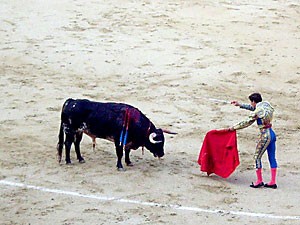Everywhere I go in Spain, I see the symbol of the bull. A billboard silhouette greets travelers as they pass from locale to locale; there must be thousands of these cutout bulls standing tall in the country. In remote flatlands, where the highways lead to somewhere more exciting, there is always the bull. On shirts, key chains, purses and other tourist paraphernalia, the proud animal is a reminder of the tradition of the bullfight.
I know that some people find bullfights to be cruel, ritualistic acts that should be stopped. Even knowing the artistic merits of the bullfight, the dance between the matador and the bull, the act of looking death in the face without fear, I was teary-eyed the first time I saw a lance sink into the animal’s spine.
I watched with a pale face and astonished eyes as the bull stumbled drunkenly and then lay down for the last time. I questioned my love for a country that celebrates such a public death of this silly animal that ran under capes and came barreling out of the corral like a gazelle from a lion. I was glad that I sat a row behind my friends and that no one paid any attention to me because I was nauseous, holding my face in my hands, uninterested in conversation.
Five more bulls were killed on that Sunday and I watched, hypnotized by the spectacle. The proceedings were elegant, the outcome was drastic, and yet I became increasingly relaxed the more death I encountered.
A picador is the person who runs straight at the bull and stabs two spines with decorated wands attached to them into the animal’s spine.
When the bulls entered the giant ring, they were fantastically energetic, running around toward the five matadors who would lure them by shouting and waving their pink capes. Bulls can vividly see colors in the red spectrum, which is why the capes were all pink and why later the matador would dance with a red cape. This charade of matador after matador waving his cape with the bull thrusting under it reminded me of ballroom dancing. It seemed that every man wanted to dance with the same lady and everyone took their turn, posing and displaying their skills as if trying to court a lover.
During a bullfight, the matador’s feet ideally stay rooted to the ground, and he ends up twisting in a semi-circle as the bull follows his cape. This entire process is very elegant, and viewers will notice the pose in a poster of a bullfight. Indeed, it is very hard to not back away from the bull when he comes close to you – only the best bullfighters gyrate to avoid being hurt, instead of walking or running away. The bullfight I attended was composed of new matadors and picadors, three young men who were still earning their honor and sometimes fumbled disastrously.
The first and best matador was Agustín de Espartinas. At the age of 20, Agustín looked baby-faced in his portrait in the program, with rosy cheeks and a wistful gaze. I didn’t see this innocent lad. I instead saw a very graceful bullfighter, who finished off what other matadors couldn’t and kept his posture in his uniform covered with jewels and sequins that glittered as he moved. Most of the matadors wore pink costumes with silver sequins and pink socks that matched their pink capes.
Álvaro Samper, 24, didn’t have any luck at this bullfight as he competed for the Jaral de la Mira trophy, an orange and pink prize founded in 1930 by Marqués de Alonso Pesquera. Álonso was neither a good picador nor matador, and he was slightly injured while fighting his first bull. He did not return for his second round, as Agustín took his place.
The best picador was the third, 19-year-old Julien “”El Santo”” Dusseing from Nimes, France.
A picador is the person who runs straight at the bull and stabs two spines with decorated wands attached to them into the animal’s spine. Literally translated, picador means “”the person who pricks or stings the bull.”” Picadors actually do as much, if not more, work than the matadors because they are running with two long and decorated picas, one in each hand, and they need to jump and bend forward over the bull’s head to get them right between his shoulders. Sometimes, picadors have to flip or twist to avoid being hurt. By the time the matador is ready to do a final dance and kill the bull, the bull has been tired out from the dancing and chasing the picadors.
Julien didn’t have much luck while trying to kill his first or second bull. The first time he was nicked by the bull’s horns, and it took him three tries to get his sword between the bull’s shoulders. It was horrifying to watch since a good matador does this quickly and precisely. By his second turn at killing a bull, he had blood spots on his butt that were clearly visible.
While trying to kill his second bull, Julien grazed his side, which was wet with blood from the picas. Julien wiped his hand on his butt, leaving a bloodied handprint.
The best performer (and most dreamy) closed the fight with his last skillful kill. After a perfect dance and execution, Agustín held up the ear of the bull as the crowd cheered and waved white handkerchiefs from the stands. The ear of the bull is a prize and the number of ears you have earned indicates how talented you are.
I believe that bullfighting is an art. My love for Spain has only bloomed now that I have been to a bullfight, organized my thoughts and realized what that proud bull on the horizon symbolizes: Life and death are inevitable and each should be celebrated accordingly.









